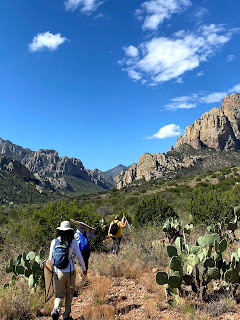I'm Off the Beaten Path!
The immense gratitude I feel while on this trip comes from a path that is still revealing itself to me. I fell in love with a school garden that my students and I, along with two other science teachers created as a school project. Thus, I committed to honor this planet via my actions. This Earthwatch expedition feels like a big thank you from Mother Nature. I never thought my learning space could be like the image below.
The energy that I am receiving from the natural world, dedicated scientists, and professional educators is fueling me. During this expedition, we have had several presentations regarding the research that we are contributing to. Dr. Lee Dyer presented on "Ecology & Evolution of Tritrophic Interaction Diversity." Graduate student Danielle Salcido, presented on "Long-term Trends in Interaction Diversity in a Tropical Lowland and Tropical Highland Forest." It was fascinating to hear about the diverse life histories of how parasitoids, such as wasps and flies, get their eggs on their caterpillar host. Parasitoids can inject their eggs inside caterpillars or place them outside the caterpillars. Some parasitoids drop many eggs as they fly over plants in hopes to deposit larvae onto catepillars. As you can see in the picture below, there is a before and after picture of a caterpillar with and without larvae.
When we were out in the field, a specific area was selected which is called a plot. In this plot, we were to count leaf estimates of the plants of interest. We then used a stick to hit the plants and gather caterpillars by placing a beat sheet below that area. We collected caterpillars in a small container along with their host plant.
When we returned to the lab, we then accessed caterpillars that were collected from the previous field day. We gathered data such as taking pictures of caterpillars. We needed lateral, dorsal and head shots. Some of these caterpillars were extremely tiny. I zoomed in to get these photo shots and then I decided to take a picture of the actual size so that I could share my reality.


We participated in lab days where there were several stations and we rotated to have access to the different tasks that were needed to collect data. One of the stations included “zoo” which required us to collect frass, or better known as poop from the caterpillar. We placed frass into microcentrifuge tubes for later genetic sequencing of a virus.
The data we gathered will now become part of the data sets that are collected and needed for this research study that has been ongoing since 2004. Being behind the scenes, allowed me to view the immense work that goes into collecting data sets. Having an inside perspective allows for greater appreciation for science. Having a first hand experience changes mind, body and soul. It is with sincere appreciation that I thank everyone that helps fund programs like Earthwatch. This was an experience of a lifetime because passion, action and collaboration meet for a common goal that affects all organisms on this planet.










Comments
Post a Comment